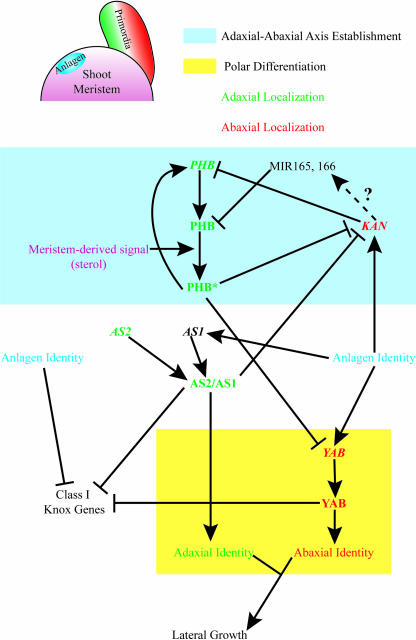Figure 3.
Conceptual framework of adaxial-abaxial polarity establishment in lateral organs of Arabidopsis. Organs arise from the flanks of shoot meristems. The organ anlage is marked by the expression of AS1 and concomitant repression of class I Knox genes. The apical meristem is the source of a putative signal(s). Reception of the signal activates the PHB protein (PHB*). Activated PHB* promotes PHB transcription and represses transcription of the YABBY and KANADI genes. PHB in turn is negatively regulated at the transcriptional and posttranscriptional levels by the KANADI genes and microRNAs 165,166, respectively. The dashed line linking KAN to MIR165,166 reflects the hypothesis that negative regulation of PHB expression by KANADIs could occur in part or in whole through KANADI activation of MIR165,166 transcription. PHB and KANADI are predicted to sort into adaxial and abaxial domains of expression, respectively, and this may establish the adaxial-abaxial axis of the lateral organ. Expression of YABBY genes is predicted based on the structure of the FIL promoter, to be localized to the abaxial domain of the organ anlagen by a combination of transcriptional activation throughout the anlage coupled with repression in the adaxial region. YABBY genes can promote differentiation of abaxial cell fates. AS2 is predicted to be expressed in the adaxial organ domain where AS2 forms a complex with AS1 (AS2/AS1) to promote repression of KANADI and differentiation of adaxial cell fates. Interactions between AS1/AS2 and other components of polarity establishment remain unclear, as does the extent to which AS1/AS2 promotes axis establishment, polar differentiation, or both processes. Both YABBY genes and AS1/AS2 repress expression of class I Knox genes. Juxtaposition of adaxial and abaxial organ domains is a requirement for the establishment of lateral growth.

